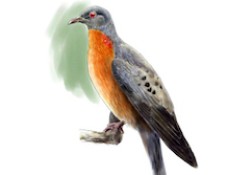From billions to none: The passenger pigeon’s genes tell us why
The passenger pigeon (Ectopistes migratorius) once numbered between 3 and 5 billion and may have formed up to 40 % of North America’s total bird population. In fact, in the mid to late 19th century, passenger pigeons were so numerous that explorers and settlers of the time wrote of infinite multitudes taking hours to fly overhead. But by 1914, there wasn’t a single bird left. How did this species go from being one of the world’s most abundant birds to extinction in just 50 years? It’s all in the genes It had been generally accepted, based on earlier studies, that widely fluctuating population numbers led to low genetic diversity in the passenger pigeon and played a role in its rapid extinction. However, a recent paper published in the journal ‘Science’ contradicts these findings. A team of researchers, one of whom drew on work carried out under the EU-funded GENETIME project, have analysed 41 mitochondrial genomes and 4 nuclear genomes from passenger pigeons. Data obtained from the species’ mitochondrial genome confirmed that the bird’s genetic diversity was indeed low given its population size. But a closer look at the entire genome yielded surprising results. Genetic variations didn’t occur evenly all along the chromosomes as the scientists had expected to find. Instead, the middle regions had low diversity and the edges higher levels. This is likely because of strong genetic selection throughout the bird’s history. Further analyses also ruled out demographic fluctuations and showed that population numbers had actually been stable for the past 20 000 years. Having eliminated population instability as a possible reason for the species’ overall low genetic diversity, the scientists turned to natural selection. To investigate the impact of natural selection on the passenger pigeon, the team compared the bird’s genome with that of its close relative, the band-tailed pigeon (Patagioenas fasciata). Given that the latter’s only true difference from the passenger pigeon is its significantly smaller population size, the scientists could use these comparisons to determine the evolutionary consequences of a big population. The fate of the passenger pigeon Through natural selection, the passenger pigeon evolved genetic traits that would help it survive as a species as long as its population was large. In fact, the bird’s considerable numbers seem to have helped it to remove harmful mutations from its genetic make-up much more quickly. This led to a significant loss of genetic diversity. Had the changes to its environment been gradual, the passenger pigeon would have been able to adapt. However, low genetic diversity made survival more difficult with the mass slaughter that ensued when the European colonists began to hunt it for commercial reasons. So, ultimately, it was humankind’s unchecked hunting practices that tolled the death knell for this now extinct bird. The GENETIME (GENETIME: An interdisciplinary training site in Ancient Biomolecules) project studied the molecules of ancient organisms in order to provide insight into the histories of both extinct and living species. The work done during the project’s lifetime is still shining a light on the processes of extinction, revealing that a sudden environmental change may bring about the extinction even of species with large and stable population sizes.
Countries
United Kingdom



